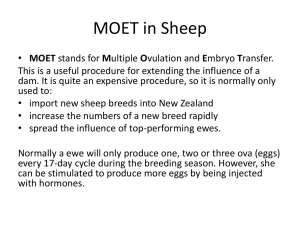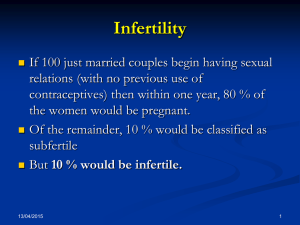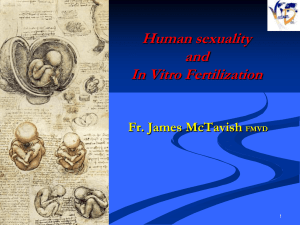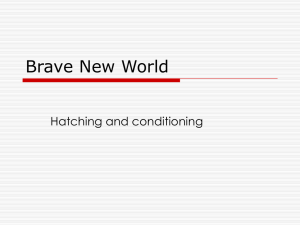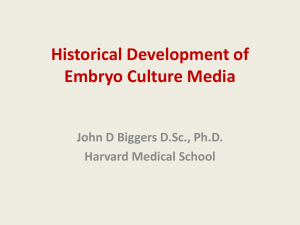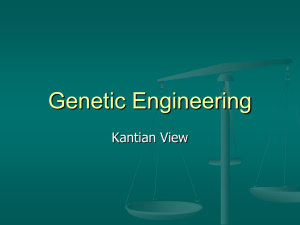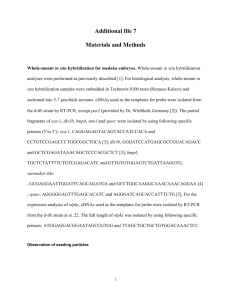MOET: Multiple Ovulation Embryo Transfer in Livestock
advertisement
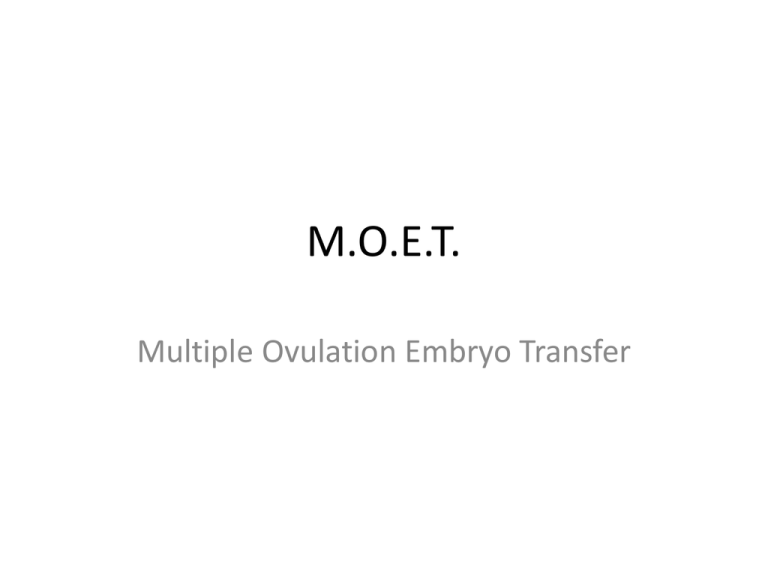
M.O.E.T. Multiple Ovulation Embryo Transfer Technology using superior Dams There are two main methods used to increase the effect of the superior dam. • Embryo transfer sometimes called MOET (Multiple Ovulation Embryo Transfer). This is where superior cows/ewes are usually artificially inseminated and then their embryos collected and implanted into recipient dams (a female that carries another dam’s embryo). • Ova transfers. The procedure is similar to embryo transfers, except that the ova are collected from the superior dam and fertilised in the laboratory (In Vitro Fertilisation – IVF) with semen from a superior sire. The ova are checked and then transferred to recipient dams. This is an expensive procedure that is used only when large numbers of ova are needed. It is used to increase the number of offspring carrying a particularly desirable but rare trait from a sire or dam. The main steps for MOET are: • controlling oestrus in donor and recipient animals • increasing ovulation (super-ovulating) • inseminating the donors • collecting the embryos from the donor animals • implanting the embryos in recipient animals. • Cattle are large animals so many of the tasks can be done with non-surgical methods. For instance, the operator can locate and feel the reproductive tract by putting an arm up the cow’s rectum (just the same as in manual pregnancy testing or artificial insemination). In smaller animals, like sheep, this would require surgery. Stages in MOET 1. Controlling and synchronising oestrus in donor and recipient cows. • Cows can be given progesterone hormone treatment like CIDRs or an implant into the ear that will prevent oestrus. 2. Super-ovulating the donor cows. • The donor cows are injected night and morning for four days with a follicle stimulating hormone (FSH) that superovulates them, increasing the ovulation rate. Superovulating makes them produce a lot more eggs (ova) than normal. 3. Synchronising heat. • The CIDRs or implants are removed and /or prostaglandin injections are given to make the animals (donors and recipients) come into heat. Cows usually come into oestrus 36 to 60 hours after the first prostaglandin injection. 4. Inseminating the donor cows. • Donor cows are artificially inseminated in the same way as most dairy cows are inseminated. • The AI technician uses a pistolet (in the right hand in this photo) guided into place by the other hand to place the semen. • The semen is placed past the cervix into the uterus. • Cows are often inseminated again 12 hours later 5. Collecting the embryos • A few days later once the embryos are fertilised and travel down the fallopian tubes they can be collected in the horns of the uterus. A solution is used to flush them out from the uterus through a Foley catheter. The inside tube of the Foley catheter carries the flushing solution that washes the embryos out of the uterus for collection. • The cuff blocks off the uterus so the solution has to flow out through the catheter and into a Petri dish The operator uses one arm in the cow’s rectum to guide the catheter in place, feel the reproductive organs, and massage the embryos from the uterus wall. The Foley catheter seals off the horn of the uterus • The solution goes through the middle of the catheter into the uterus and the embryos are gently massaged from the uterus wall. • The solution with the embryos then drains back through the middle of the catheter and down to a collecting filter and jar. Details of collecting the Embryos • The solution drains down from the bag through a tube to a Y-shaped join that connects with the Foley catheter in the horn of the uterus. • Clamps block off the lower tubing so the solution goes into the Foley catheter. • Then the top clamp is closed and the bottom one opened. The embryos in the solution then drain back out of the catheter to the Y-shaped join and flow down to the filter. • The embryos collect in the filter and are then rinsed from the filter into a dish. Transferring the Embryos • Embryos should be transferred as quickly as possible into the recipient cows. • They are placed back into the horn of a uterus of a recipient cow. This cow must have a corpus luteum present. The operator checks to feel for the corpus luteum, which is a small red swelling in the ovary. If there isn’t a corpus luteum detected then that cow can’t be used as a recipient. The corpus luteum and the hormones it produces are needed to maintain pregnancy. • The embryos can be transferred using surgery or by using an AI pistolet with the embryos held in an insemination straw. The embryos are released as far up the uterine horn as possible without causing any injury. • If the surgical method is used then a local anaesthetic is given to the cow and a small 50mm cut made in the side. The uterus and ovaries are carefully brought near the opening of the cut and the embryos are syringed directly into the uterus. The cut is then stitched up. • The surgical method has a slightly higher pregnancy rate but risks infection. The non-surgical method is quicker and cheaper. • Unused embryos can be frozen for use later on. • Collecting and implanting embryos can be done using surgical methods or non-surgical methods. Non-surgical techniques are used on larger livestock animals like cattle as the operator can feel the reproductive organs through the cow’s rectum. Smaller animals, like sheep and goats, need surgery. This is because the operator can’t work inside small animals without using surgery to carefully pull out the reproductive tract and perform the tasks needed. Questions: 1. After the embryos are collected using MOET they are checked in a microscope. • Explain why this is carried out. 2. Embryo transfer is an expensive technique. However, if it was used on commercial dairy farms explain how performing ET on a high-milkproducing cow could lead to an increase in a dairy farmer’s financial returns.

